Instruction Manual
Hazardous Area Oxymitter 4000
TOXICOLOGY
A number of studies on the health effects of inhalation exposure of rats and hamsters are available. Rats were exposed to RCF in a series of
Animals exposed to 30 and 16 mg/m3 were observed to have developed a pleural and parenchymal fibroses; animals exposed to 9 mg/m3 had developed a mild parenchymal fibrosis; animals exposed to the lowest dose were found to have the response typically observed any time a material is inhaled into the deep lung. While a statistically significant increase in lung tumors was observed following exposure to the highest dose, there was no excess lung cancers at the other doses. Two rats exposed to 30 mg/m3 and one rat exposed to 9 mg/m3 de- veloped masotheliomas.
The International Agency for Research on Cancer (IARC) reviewed the carcinogenicity data on
EMERGENCY FIRST AID PROCEDURES
EYE CONTACT
Flush eyes immediately with large amounts of water for approximately 15 minutes. Eye lids should be held away from the eyeball to insure thorough rinsing. Do not rub eyes. Get medical attention if irritation persists.
INHALATION
Remove person from source of exposure and move to fresh air. Some people may be sensitive to fiber induced irritation of the respiratory tract. If symptoms such as shortness of breath, coughing, wheezing or chest pain develop, seek medical attention. If person experiences continued breathing difficulties, administer oxygen until medical assistance can be rendered.
INGESTION
Do not induce vomiting. Get medical attention if irritation persists.
SKIN CONTACT
Do not rub or scratch exposed skin. Wash area of contact thoroughly with soap and water. Using a skin cream or lotion after washing may be helpful. Get medical attention if irritation persists.
SECTION VI. REACTIVITY DATA
STABILITY/CONDITIONS TO AVOID
Stable under normal conditions of use.
HAZARDOUS POLYMERIZATION/CONDITIONS TO AVOID
N.A.
INCOMPATIBILITY/MATERIALS TO AVOID
Incompatible with hydrofluoric acid and concentrated alkali.
HAZARDOUS DECOMPOSITION PRODUCTS
N.A.
Rosemount Analytical Inc. A Division of Emerson Process Management |
